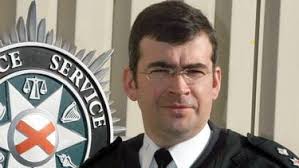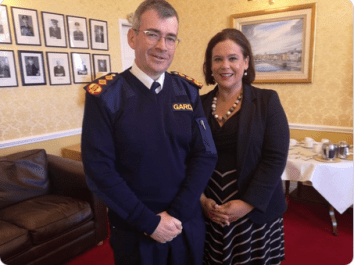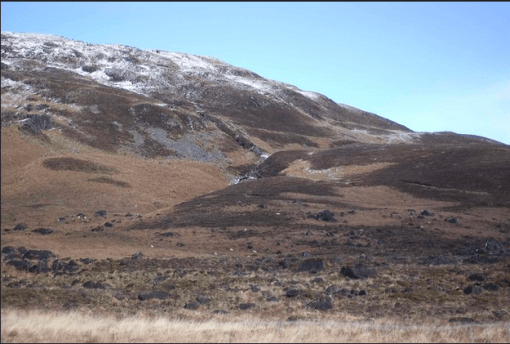
Tom Oliver, alleged Garda Special Branch agent in Co. Louth, whose killing by the IRA is at the centre of a dispute involving Drew Harris, current Garda Commissioner and former PSNI Deputy Chief Constable
Controversial evidence given by current Garda Commissioner, Drew Harris to the Smithwick Tribunal investigating collusion allegations between the Provisional IRA and Garda detectives, which appeared to implicate the Sinn Fein leader, Gerry Adams in the 1991 IRA killing of Co. Louth farmer and alleged Garda agent, Tom Oliver, has been challenged by IRA sources with intimate knowledge of the affair.
Although the sources declined to go on the record, the strength of their testimony derives not just from the detail of their denial but their long time opposition to Gerry Adams’ political and military strategy. Ordinarily, they would be the last people to come to Adams’ aid; in this instance it was Garda Commissioner, Drew Harris’ allegedly error-strewn testimony which was the principal motivating force.
Although the then PSNI Assistant Chief Constable declined to publicly name Gerry Adams at the Smithwick Tribunal or hint at his identity, Drew Harris wrote down the name of the IRA leader allegedly instrumental in confirming Tom Oliver’s death sentence on a sheet of paper which was handed to the tribunal chairman, Judge Peter Smithwick.
Despite the confidentiality surrounding this exchange there was almost immediate speculation in legal and media circles in Dublin, that Harris had named Gerry Adams.
Here are the competing versions of the IRA’s killing of 49-year old, father of seven, Tom Oliver, a dairy farmer from the Cooley peninsula near Dundalk, Co Louth.
First the account given to the Smithwick Tribunal by the current Garda Commissioner, Drew Harris, when he was Assistant Chief Constable of the PSNI responsible for intelligence matters, including liaison with the British intelligence service, MI5. Judge Smithwick makes it clear that he understands Harris version of events is shared and endorsed by MI5.
That is followed by the IRA’s explanation of events.
There is no meaningful common ground in the two versions except that at the end, the IRA took Tom Oliver’s life and justified their action on the grounds that the dead farmer and father was working for the Garda Special Branch. There is, however, much to ponder.
DREW HARRIS’ VERSION

Drew Harris in his PSNI days
When Drew Harris gave evidence to the Smithwick Tribunal in October 2012, he was an Assistant Chief Constable of the PSNI in charge of intelligence matters and was the force’s official conduit to MI5, Britain’s domestic intelligence service.
He had strong reasons to loathe the Provisional movement and its leaders; in 1989, two years before the death of Tom Oliver, his father, Alwyn Harris, a Superintendent in the old RUC was killed in a booby trap car bomb planted by the IRA. He parents were en route to a church service when the device, planted under the driver’s seat of his car, detonated. Somehow, Drew Harris’ mother escaped serious injury.
These devices cause horrible and invariably deadly damage to the human body. Called ‘Up and Unders’ by the IRA, they consist of a small quantity of Semtex explosive which the bomber affixes to the undercarriage of the vehicle, directly underneath either the driver or the passenger, whichever is the target.
The bomb is activated when a small globule of mercury, trapped inside a glass tube, slides from one end to the other and completes an electrical circuit. This usually happens when the moving car encounters a slope. The force of the explosion, which is driven upwards by the road surface, causes horrible internal injuries, severing major arteries, amputating limbs and causing massive shock which usually kills.
Drew Harris would not be human if, when he meets Sinn Fein activists in his new manifestation as Garda Commissioner, he did not pause and remind himself that these are people whose paramilitary colleagues killed his father.
Enmity between Harris and the Provo leadership was further stoked when as head of the PSNI Crime department, he ordered the arrest of Gerry Adams for questioning about the disappearance of Jean McConville. Adams had been named by Brendan Hughes in the Boston College archive and his arrest infuriated the Provos. When Drew Harris was later nominated for promotion to PSNI Deputy Chief Constable, the SF representative on the policing board withdrew in protest.
While Drew Harris has kept any negative feelings he has about the Provisional leadership out of the public arena, Gerry Adams and his confreres have made no secret of their hostility towards him, although Adams’ successor as SF leader, Mary Lou McDonald has been anxious to be seen, smiling and apparently amiable, in the new Garda Commissioner’s company.

Mary Lou McDonald meets new Garda Commissioner, Drew Harris, November 2018
Drew Harris was not initially scheduled to give evidence to the Smithwick tribunal. That was supposed to be the sole task of PSNI Chief Superintendent Roy McComb, who initially submitted just three items of intelligence to the inquiry.
McComb told Judge Smithwick when cross-examined in May 2012, ‘…that the PSNI held no more intelligence relevant to the terms of reference.’
Then, a few weeks later, Drew Harris turned up, bearing no less than seventeen extra items of intelligence for the Tribunal, a total of twenty intelligence reports, and asked if he could give evidence.
Judge Smithwick agreed: “Assistant Chief Constable Harris had more knowledge of the intelligence than his colleague Detective Chief Superintendent McComb, and had, unlike Detective Superintendent McComb, access to all the raw intelligence upon which the 20 precis were based“.
Drew Harris’ evidence was heard in camera, although a suitably redacted version was eventually published by the Tribunal.
He was asked why, if so much intelligence existed on Garda collusion with the IRA, Chief Superintendent McComb had told the Tribunal that the three items he had brought with him were all that existed in the PSNI’s files?
Harris’ explanation was that some of the extra seventeen intelligence reports were only received after May 2012, when C/S McComb had given evidence, while others were in the files but were only retrieved afterwards. “Accordingly, Detective Chief Superintendent McComb was not aware of them“, Harris said.
It must be remembered that Tom Oliver was killed in 1991, yet Harris claimed that some of the new intelligence had only been received in the summer of 2012, some twenty-one years later
Drew Harris then told Judge Smithwick that he was ready to stand over the newly presented testimony. While he was not in a position to give a grading to each item, he himself “had viewed the underlying raw intelligence” and was happy to stand over it as being “accurate and reliable“.
The Assistant Chief Constable went on to assure the Tribunal chairman that the PSNI (and presumably MI5) was happy about the sources, which were both human and “technical”, i.e. obtained electronically, presumably via bugs, that the intelligence was not “circular”, i.e. the same information repeated by different individuals who knew each other, and was not derived from “mischievous or ill-informed sources” but had been reliably corroborated.
But then came a thunderbolt. Previous intelligence evidence given to the Tribunal by the PSNI had been supported by the raw, underlying, unredacted intelligence which had been made available by the Northern police to Judge Smithwick.
But not this new evidence, the seventeen new items added by Drew Harris to the three items submitted by Detective Chief Superintendent McComb.
Judge Smithwick explained: “….this was a deviation from the normal practice whereby the PSNI allowed the Tribunal access to unredacted intelligence so as to verify that the precis accurately reflected the essence of the intelligence. (Harris) explained that this new procedure had to be applied in respect of ‘live and of the moment’ intelligence: ‘Given the sensitivity of the information that is being provided. I think this is the prudent way of dealing with this and managing the risk that we are taking in providing the information’.”
In other words Drew Harris was telling Judge Smithwick that he had some dynamite evidence to give but only on condition that nobody involved in the Tribunal would get to see where it came from or be able to judge how reliable it was. The judge and everyone involved in the Tribunal would have to take Harris’ word for it.
And thus was the killing of Tom Oliver made part of the Smithwick Tribunal and with that, the allegation that Gerry Adams had given the final order to kill the Cooley farmer.
The first two new alleged pieces of PSNI/MI5 intelligence linked the Tom Oliver killing to the assassinations of the two RUC officers, Chief Superintendent Breen and Superintendent Buchanan, whose killings, amid allegations that the IRA had inside information about their movements from Garda moles, led to the establishment of the Smithwick probe.
The Garda detective who had set up the two policemen for the IRA then, according to Drew Harris, told the IRA about Tom Oliver’s spying activity, effectively sentencing him to death.
The relevant written testimony provided by Harris read: “Strand 5: Intelligence indicates that this AGS (An Garda Siochana) officer also provided information in relation to Tom Oliver and continued to provide a variety of information to PIRA for a number of years. It is believed that this AGS officer is now retired. This AGS officer was handled as a source by a senior member of PIRA“.

Gerry Adams outside Sinn Fein’s Falls Road headquarters
Without this claim, the IRA’s killing of Tom Oliver would have fallen outside the terms of reference of the Smithwick tribunal and the associated claim of involvement by Gerry Adams might well have remained a secret, assuming that it was based on real intelligence in the first place.
The evidence provided by Drew Harris which led to that speculation concerning Gerry Adams was contained in three strands of PSNI intelligence, items 16, 17 and 18. They read thus:
21.14.13 Strand 16:
“Sinn Fein/PIRA members remain concerned that the Smithwick Tribunal continues to disclose possible damaging information. Sinn Fein/PIRA members remain concerned that specific detail regarding the murder of TOM OLIVER may be disclosed.”
21.14.14 Strand 17:
“Intelligence indicates that a senior PIRA Army Council member was directly involved in ordering the murder of TOM OLIVER. The senior PIRA Army Council [“PAC”] member had been approached by several PIRA members and others requesting that TOM OLIVER not be killed. Despite these requests, the senior PAC member directed that OLIVER be executed.”
21.14.15 Strand 18:
“Further intelligence suggest that a senior PIRA figure sought direction and instruction from a senior PAC member in relation to the discovery of allegations of TOM OLIVER being an AGS informant. The senior PAC member subsequently ordered OLIVER to be executed.”
Judge Peter Smithwick then remarked: “The name of the senior PIRA figure referred to in this intelligence was provided to me by Assistant Chief Constable Harris in writing during the course of his evidence to the Tribunal.”
It wasn’t long before Gerry Adams’ name was circulating, first in the law library in Dublin and then amongst the media. RTE’s Miriam O’Callaghan put the allegation directly to Gerry Adams, which he denied, in an interview in March 2015.
Summary: Drew Harris’ intervention at the Smithwick tribunal with seventeen pieces of new intelligence came after the PSNI representative had told the hearing that the three items he had submitted was the sum of PSNI knowledge of Garda collusion with the IRA. Drew Harris told the tribunal that he would submit his seventeen new pieces of intelligence, which included a claim that a senior IRA figure, said to be Gerry Adams, gave final approval to Tom Oliver’s killing, on condition that no PSNI supporting evidence for his claims would be given to the tribunal. His new evidence could not, and would not be checked. But if he did bring false information to Judge Smithwick, that was a huge risk to take, one that would, if exposed, almost certainly end his policing career in disgrace.
PROVISIONAL IRA VERSION
I am calling this the ‘Provisional IRA’ version of Tom Oliver’s death since at the time the farmer was killed, the source was a senior figure in that organisation, but has since left it.
The Provisional version of the Tom Oliver killing rests upon the claim that the dairy farmer was a much more important source for the Gardai than media reports have claimed or that the authorities have admitted.
These suggested that Tom Oliver had stumbled upon a cache of IRA weapons on his land, had reported it to the police and, in revenge, was then killed by the Provos who recorded him talking by phone to his handler in a local Garda station.
(This reporter listened to portions of the tape back in 1991 and very little of what I was able to hear was either clear or convincing.)
The Provo version paints Tom Oliver as a much more serious police agent who was working with the Garda Special Branch in an effort to locate an IRA explosives factory located in the Cooley mountains adjacent to his dairy farm on the Cooley peninsula. The factory processed sodium nitrate fertilizer (of the sort which recently devastated Beirut) for use in IRA bombing operations in Northern Ireland.
Discovery of the facility would deliver a serious blow to the IRA and make Tom Oliver, in the eyes of the IRA – and presumably the Garda Special Branch – an important source.

Part of the Cooley mountain range
It was the threat that he supposedly represented to the IRA’s bombing capability which helps explains the savagery of his death: seven bullets fired into his head. That was done, the IRA later claimed, to send a message to people in the area tempted to work for the Gardai.
The IRA version also strongly disputes Drew Harris’ claim that there was an appeal-type process in which ‘several PIRA members‘ approached ‘a senior PIRA Army Council (PAC) member‘ seeking mercy for Tom Oliver. This, presumably, was Gerry Adams, whose family has had a holiday caravan on the Cooley peninsula for many years.
Despite this, said Harris’ intelligence, ‘….the senior PAC directed that OLIVER be executed.’
Not possible, say IRA sources.
In the IRA procedure against alleged agents or informers, the process culminates in two members of the Army Council examining the evidence and questioning the accused and his/her interrogators before then, assuming the accused has admitted guilt, confirming the sentence or, in the absence of an admission, agreeing the accused’s guilt or innocence.
In other words an appeal process, if such it can be called, had already happened and the effort to involve Gerry Adams could not happen and did not happen.
Summary: Like Drew Harris’ testimony to the Smithwick tribunal, the IRA version can not be tested and nor does any independent evidence exist to support their claim that Tom Oliver was an important spy. His family continue to insist on his innocence. The IRA’s internal procedures are usually kept secret so there is no independent source to verify internal procedures when dealing with alleged spies. But the account of how such matters are dealt with, and the sheer brutality of his death do not sit easily with the version given by Drew Harris’. Equally, the sources have no reason whatsoever to wash Gerry Adams’ dirty laundry.










